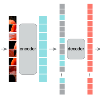Eye-Tracking data is a very useful source of information to study cognition and especially language comprehension in humans. In this paper, we describe our systems for the CMCL 2022 shared task on predicting eye-tracking information. We describe our experiments with pretrained models like BERT and XLM and the different ways in which we used those representations to predict four eye-tracking features. Along with analysing the effect of using two different kinds of pretrained multilingual language models and different ways of pooling the tokenlevel representations, we also explore how contextual information affects the performance of the systems. Finally, we also explore if factors like augmenting linguistic information affect the predictions. Our submissions achieved an average MAE of 5.72 and ranked 5th in the shared task. The average MAE showed further reduction to 5.25 in post task evaluation.
翻译:眼跟踪数据是研究人类认知力,特别是语言理解的非常有用的信息来源。在本文中,我们描述了我们CMCL 2022系统在预测眼跟踪信息方面共同承担的任务。我们描述了我们用BERT和XLM等预先培训的模型进行的实验,以及我们利用这些模型预测四个眼睛跟踪特征的不同方式。除了分析使用两种经过预先培训的多语种语言模型和汇集象征性代表的不同方式的影响外,我们还探讨了背景信息如何影响这些系统的业绩。最后,我们还探讨了增加语言信息等因素是否影响预测。我们提交的资料平均达到5.72兆赫,在共同任务中排名第5位。平均MAE在任务后评价中进一步降至5.25兆。




